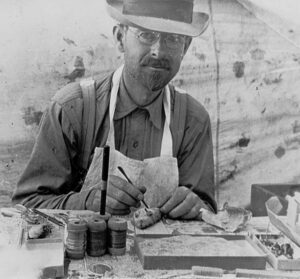
The Foundation of Scientific Field Observation
Dr. Joseph Grinnell (1877-1939) developed a field notation system for naturalists that revolutionized how scientists document observations. His method trained generations of researchers to see more, remember more, and record with precision.
Core Principle
Record only what you directly experience with your senses. No conjecture. No interpretation. No assumptions. Just the observable facts of the moment, captured as soon as possible.
Grinnell’s Rule: “No notes, no sleep” Write your observations immediately, even under difficult conditions. The longer you wait, the more memory rewrites what you actually experienced.
Standard Field Note Structure
- Date – When the observation occurred
- Time – Specific time of observation
- Location – Precise place (coordinates, landmarks, descriptions)
- Route – Path traveled to reach the observation site
- Weather – Temperature, cloud cover, wind, precipitation
- Observations – Detailed sensory data only
What to Record
- What you see, hear, smell, touch
- Colors, textures, sizes, distances
- Behavior (if observing animals)
- Specific details that distinguish this moment from others
- Conditions that might affect your observations
What to Exclude
- What you think something means
- Why you believe something happened
- Comparisons to past experiences (unless documenting change)
- Speculation about future events
Why It Works
- Sharpens attention: Regular practice trains your mind to notice details you would otherwise miss.
- Builds reliable records: Notes can be reviewed years later by you or other researchers.
- Separates observation from interpretation: Keeps raw data clean for later analysis.
- Creates institutional value: Grinnell’s own field notes are still used by researchers today, nearly a century later.
The Long-Term Benefit
Scientists who use the Grinnell system consistently report that their observational skills improve dramatically. They begin noticing patterns, details, and changes that were invisible to them before. The method trains perception itself.
For Research Institutions
Field journals using the Grinnell system become permanent scientific records. Many institutions require field scientists to maintain these notes as a condition of employment and to hand them over upon completion of research.
Legacy
Grinnell’s field notes from the early 1900s are housed at the Museum of Vertebrate Zoology at UC Berkeley. Researchers still consult them to understand historical species distribution, behavior, and environmental conditions. Well-maintained field notes outlive their authors and continue serving science for generations.
The Standard for Field Science
The Grinnell method remains the standard practice throughout field-deployed scientific communities. It has proven itself for over a century as the most reliable way to capture observational data.
Bibliography
Herman, Steven G. The Naturalist’s Field Journal: A Manual of Instruction Based on a System Established by Joseph Grinnell. Vermillion, SD: Buteo Books, 1986.
The definitive instructional manual on Grinnell’s field documentation system. Herman explains the four-part method: field notebook (immediate observations), species account (specimen-level detail), collection catalog (systematic inventory), and field journal (expanded daily narrative). Essential for understanding how to implement Grinnell’s philosophy practically. Though focused on natural history, the system adapts directly to built environment documentation. Out of print and expensive, but remains the most comprehensive treatment of the method.
Grinnell, Joseph. “The Methods and Uses of a Research Museum.” Popular Science Monthly 77 (1910): 163-169.
Grinnell’s foundational essay establishing that field notes serve future researchers, not just the original observer. Argues for standardized, detailed documentation capturing context invisible to the note-taker but critical for later analysis. Essential for understanding why field notes require rigor beyond personal memory.
Harper, Dan. “A Field Journal for Naturalists.” 2021. https://www.danielharper.org/yauu/wp-content/uploads/2021/06/A_Field_Journal_for_Naturalists.pdf.
Practical guide to implementing Grinnell’s system with modern tools. Covers material selection (paper, pens), format specifications, and integration with digital platforms like smartphones. Includes examples from historical field journals and addresses common challenges. Accessible introduction for beginners while respecting the system’s rigor.
Long, Donna L. “Keeping a Naturalist’s Field Journal: The Grinnell Technique.” 2012. https://donnallong.com/wp-content/uploads/2012/10/grinnell-handout.pdf.
Accessible practical guide by a professional garden writer who successfully adapted Grinnell’s system for creative work. Includes observation checklists, formatting guidelines, and concrete tips for implementation. Explicitly permits reproduction for educational purposes. Long demonstrates how the method improves observational thoroughness and makes accumulated data actually useful for writing projects. Ideal introductory handout for workshop participants—much more accessible than Herman’s expensive out-of-print book while covering all essential components.
